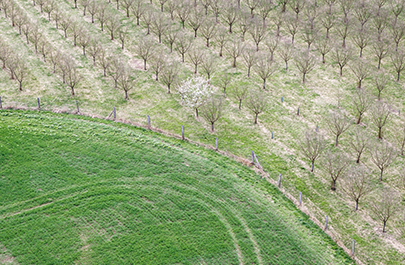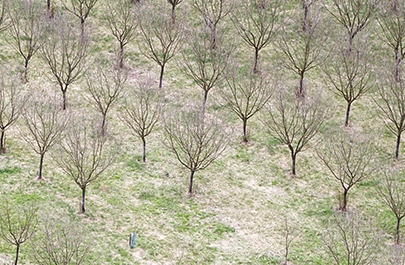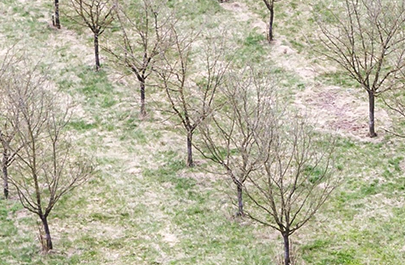






Commercial apple cultivation has changed dramatically since the 1970s, as it has for most fruit trees. In contrast to the large-canopy, high-stemmed labour intensive trees that were dominant until then, commercial cultivation today uses only the low-stemmed form. Thus,10 to 20 times more trees can be grown in the same area. Their height is limited so that all work can be done by hand without a ladder. Cherries for the processing industry are often harvested mechanically. In the mid-nineteenth century about 2000 varieties of apples were known, while today there are only 20-30 varieties of economic importance.
(Unit/t of production)
(Unit/t of production)
N
1.7
0.6
Very Sensitive
P2O5
0.9
0.4
Sensitive
K2O
2.9
2
Very Sensitive
CaO
4.9
0.1
Very Sensitive
MgO
0.9
0.2
Sensitive
TE
Boron (B), if required
1. Topsoil fertilization
Granulated fertilizers are applied with the fertilizer spreader. The big advantage of this application technique is a high performance per hectare and the fact that technology is universally available.
2. Fertilization of the tree rows
Best suited for N fertilization in liquid form. Liquid fertilizer is dissolved in the tank and can be applied with herbicide. The nutrients are more targeted to the plants when applied like this.
3. Fertigation
Fertigation is the addition of fertilizer to the irrigation water using suitable equipment. The advantage of fertigation is that the nutrients are applied continuously and in a targeted manner. The increased use of drip irrigation systems in orchards has also increased the importance of fertigation.
4. Foliar feeding
Foliar applications are suitable when deficiencies need to be compensated for as quickly as possible. The roots cannot absorb all the required nutrients at the desired rate (under specific soil or weather conditions). At this time, one or more applications of foliar fertilizer make sense. Nutrients that miss the leaf can also be absorbed from the soil.
Nitrogen fertilization

Calcium fertilization

Magnesium

Nitrogen fertilization is carried out in two to three doses once growth has started, shortly before flowering until the end of June. The trees absorb nitrogen mainly as nitrate. Nitrate (anion) can promote the uptake of cations such as calcium (Ca2+), magnesium (Mg2+) and potassium (K+). N doses can be applied in a targeted manner to the tree rows and only occasionally to the tramlines. If the N fertilizer is concentrated at the tree rows only, the concentration (N per area) should not exceed twice the concentration, which would be used at the total area. The total amount can be concentrated on the strip if used together with P, K, and Mg. N fertilization can be done very well in liquid form (herbicide boom sprayer or via irrigation). Young trees are fertilized according to their stage of development.
Calcium is provided as chloride, oxide or chelate to prevent physiological disorders such as bitter pits, flesh browning, soft pulp, etc. Often one to two treatments, five and three weeks before harvest, are sufficient. Susceptible varieties or trees with low fruit setting need four to six treatments, approximately every ten days. Calcium is important for cell wall strength and cell wall growth and thus, for good storage quality and shelf life.
Depending on growth and yield, the annual extraction of MgO is approximately 30kg/ha. The leaves take up two thirds but remain largely in the nutrient cycle. The use of Mg-containing limestone in the course of a preservation liming is favourable.
LAT Nitrogen Austria GmbH
St.-Peter-Strasse 25
4021 Linz, Austria














